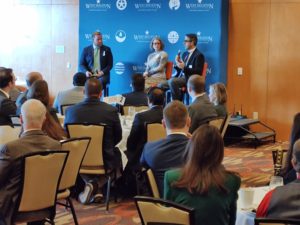
On February 9th WHA hosted our first forum of 2023 with a crowd of over 100 people at the Embassy Suites Energy Corridor. The forum, entitled “Success in Business & Development Through Nature-Based Infrastructure” was co-hosted by our Sustainable Infrastructure Committee and our Parks, Recreation, and Open Spaces Committee. The event featured guest speakers, Mary Keilers, Innovation and Research Principal at Clark Condon Associates, Pouyan Layegh, Associate Vice President for Engineering and Building Systems Management for MD Anderson Cancer Center, and moderator, Harry Thompson, Associate with Allen Boone Humphries Robinson and Vice Chair of the WHA Sustainable Infrastructure Committee.
Nature is important in our planning and development. Christina Cole, Chair of WHA’s Parks, Recreation, and Open Spaces committee introduced the panel saying, “It is essential for our communities to thrive, it is essential for the mental and physical health benefits of our residents, for the growth of our children, it is essential in our engineering as it provides additional drainage benefits to reduce flooding; it is essential in true quality planned development, and it is required today to remain competitive.”
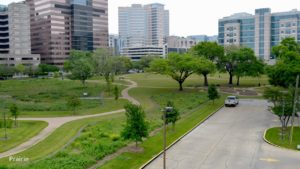
The event followed along with the parts of the “Triple Bottom Line” concept often referenced when discussing the importance of Sustainable Infrastructure. As Harry explained, “the Triple Bottom Line concept is a sustainability framework that measures an infrastructures success in three main areas: social, environmental, and economic.” With this framework in mind, the forum started off by discussing social and health success Pouyan and Mary had seen in the field of natural based sustainable infrastructure, then moved into environmental benefits, and concluded on economic issues.
The relationship between nature and human health has been documented previously by academia, but the forum made the connection between infrastructure and health. Pouyan identified that nature-based infrastructure has demonstrable positive impacts on patients, as well as their families. “Coming to MD Anderson is a highly stressful event, and having an area to decompress and gather has proven to help all who come through this system.”
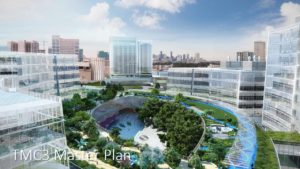 There are also wider effects on employees that can have impacts across commercial developments more broadly. Pouyan noted, “Not only do these facilities improve our patients’ health, but they also lead to our researchers and employees having a much-needed outlet. Employees oftentimes spend long hours inside our hospitals or research areas, so being able to have access to nature has led to a happier and more productive work force.”
There are also wider effects on employees that can have impacts across commercial developments more broadly. Pouyan noted, “Not only do these facilities improve our patients’ health, but they also lead to our researchers and employees having a much-needed outlet. Employees oftentimes spend long hours inside our hospitals or research areas, so being able to have access to nature has led to a happier and more productive work force.”
These nature-based infrastructure components come in a wide range of forms. It could be as simple as being able to look out a window and see trees or it could be a walking path around a pond next to an office building. The pond can have a dual purpose, not just being an attractive amenity, but also serving a detention purpose or even providing a habitat for local wildlife. Additionally, green spaces do not have to be highly manicured to be effective. They could instead be left as more native grasslands which would have an even greater environmental impact. Another benefit identified by the panel is that these amenities have been shown to increase workforce retention. Having a more pleasing work environment gives people something to look forward to as they come to work knowing that their breaks can be more peaceful than a simple coffee room.
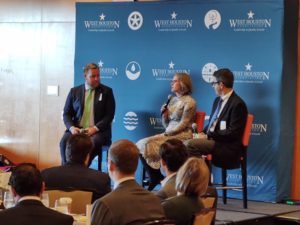
The elephant in the room with this discussion is always the costs involved. There often needs to be a demonstrable return on investment. The panelists reminded the audience that our focus in implementing this type of nature-based infrastructure projects should not just be on initial cost. As Mary pointed out, “Yes, sometimes these projects cost more up front. However, the long-term economic benefits of these types of projects have been proved to reduce costs for the life span of these facilities.” For example, native plantings require fewer maintenance visits, decreasing costs. They also require less water, decreasing water costs. Marry suggested that the long-term cost benefits should be factored heavily into any consideration into these types of projects. For example, the economic benefit of employee retention or a more productive workforce.
It is important that the economic analysis be balanced with the social and environmental successes. The panel wrapped up reminding the audience of the “Triple Bottom Line” approach. The reality is that it will cost more up front. However, there will be long-term economic benefits. Moreover there will be social and environmental benefits that might just be a little harder to measure.
Thank you to our sponsors of the event!
Gold

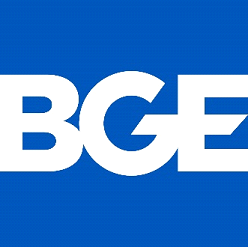

Silver




Bronze


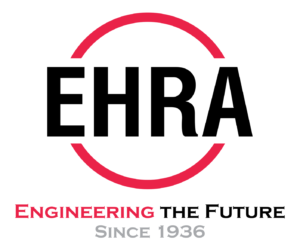
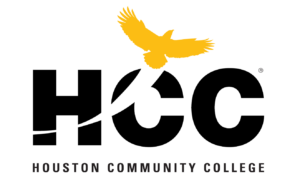



![]()
![]()






